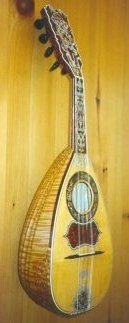What’s a mandolin? This is a frequently asked question by all age groups. Quite simply the mandolin is a small plucked string instrument with a fingerboard which came originally from Italy. The most usual type used in classical music today is called the Neapolitan mandolin and its body, shaped like half a pear, has a rounded back which is made from strips of moulded wood called ribs. It has eight strings which are tuned in pairs to g-d’-a’-e”, similar to a violin.

|
| Baroque mandolin |
In the past there were many different kinds of mandolins. Just as today you will find different food in different parts of Italy, different ingredients and different recipes, so it was with mandolins. For example, if you visited Venice in the eighteenth century you would find an instrument tuned in pairs to five notes: b-e’-a’-d”-g” (the Venetian mandolin). If on the other hand you went on a trip to Milan in Lombardy you would have found an instrument with an extra pair of strings tuned g-b-e’-a’-d”-g” (the Lombardian mandolin). Not that far away in Brescia was another instrument with only four strings (not paired) tuned exactly like a violin. This instrument was called the Brescian mandolin and was also sometimes known as the Cremonese mandolin.
Other types of mandolin included the Genoese mandolin from Genoa which was tuned e-a-d’-g’-b’-e” (one octave higher than the modern guitar) and a nineteenth century development, the Milanese mandolin which had six single strings tuned to the same notes as the Lombardian mandolin.
Today it is also possible to see another kind of mandolin sometimes described as the flat-backed mandolin which has developed outside of Italy and become popular in other genres of music such as folk, jazz and pop.
Another question that is often asked is who invented the mandolin? Well it evolved as many things do but there was a remarkably similar plucked string instrument called the gittern which existed in various parts of Europe during the medieval period. It was played alongside the larger and more familiar lute. The interesting thing is that it had a pegbox shaped like a sickle, echoing the shape of the Embergher and Percoraro mandolins used today, more than five centuries later.
At the end of the sixteenth century another instrument which preceded the mandolin appeared in France called the mandore. The spelling of mandolin is similar to mandore sharing the same root, mando. This is also the case when translated into Italian (mandolino), French (mandoline) or German (mandoline).
Sometimes confusion is caused in English speaking cultures by the use of the term mandolino for early mandolins but in Italy every type of mandolin is referred to as mandolino with its regional name if further clarification is necessary. This is because mandolino is the literal translation of the word mandolin.
